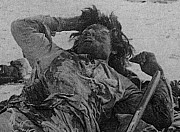"Interpretations of Wounded Knee 1973 and 1890" is meant to help foster understanding and build stronger relationships between Natives and non-Natives as the 40th anniversary of the Wounded Knee takeover approaches, said Timothy Hoheisel, director of Outreach and Promotion at The Center for Western Studies.
In 1890, the U.S. Army killed Miniconjou Lakota chief Spotted Elk, also known as Big Foot, and 300 of his followers, including women and children, on the banks of the Wounded Knee Creek.
"I didn't do anything to Jerry Fogg. My ancestors basically killed his ancestors," said Hoheisel, referring to the 1890 massacre. "By us coming together with this exhibit, there's a chance for reconciliation."
The exhibit is a prelude to the annual Dakota Conference, which brings together professional and amateur historians and researchers to present papers on a particular topic relevant to Northern Plains history. The theme for this year's conference is "Wounded Knee 1973: Forty Years Later." The event, scheduled for April 27-28, is bringing together all sides from the occupation—former American Indian Movement members, federal agents and prosecutors, and journalists and bystanders who witnessed the uprising.
"We crucify Christ every day by not dealing with Native American disparity and rights," Preheim wrote in his artist description of the piece.


No comments:
Post a Comment
Note: Only a member of this blog may post a comment.